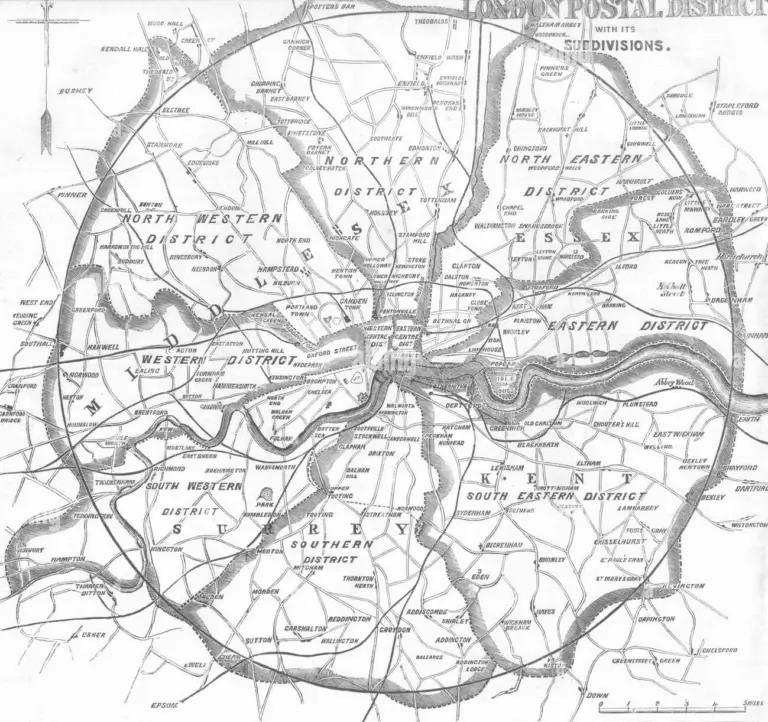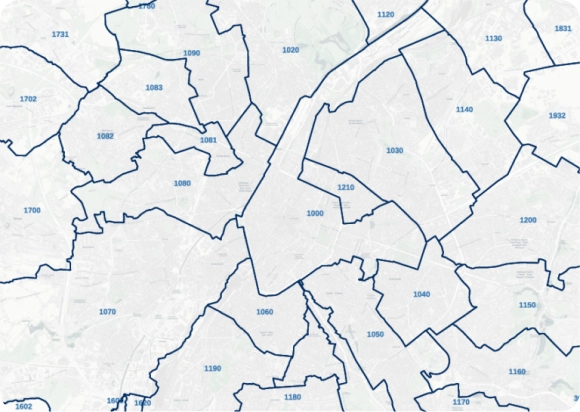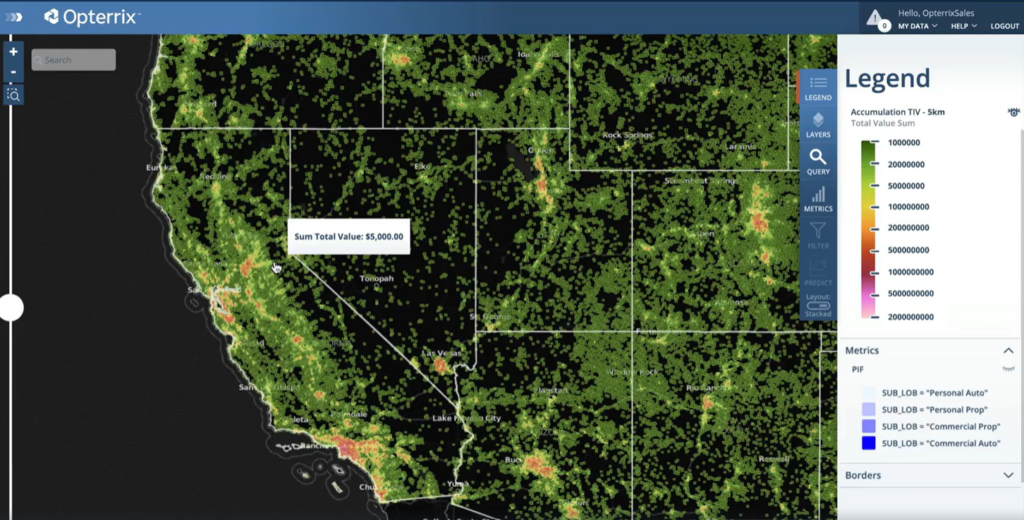Key Takeaways
- Postal codes enable efficient mail delivery, online shopping, and marketing as keys to geographic data
- Postal code structures vary globally, using numeric, alphanumeric, or variable-length formats
- Technology like barcodes and geocoding modernizes postal codes for faster sorting and analysis
- Businesses use postal codes to understand customers, segment markets and optimize logistics
Introduction
Known as postal codes, these digits are pivotal for swift and accurate mail dispatch. Referred to as zip codes in the United States and other nations, postal codes are an integral part of the international mail organization framework.
The following passages delve into the essence of postal codes, their inception, function, and critical role in mail delivery. We’ll address common queries related to postal codes, such as finding and using them and their implications for business and marketing.
💡 For over 15 years, we have created the most comprehensive worldwide postal code database. Our location data is updated weekly, relying on more than 1,500 sources. Browse GeoPostcodes datasets and download a free sample here.
The Birth and Evolution of Postal Codes
Postal codes have been around for quite a stretch, tracing back over a hundred years across various continents. Let’s journey through the commencement, evolution, and the various forms of postal codes globally.
Origins of the Postal Code System
The concept of postal codes first surfaced in London in 1857. The bustling city was divided into 10 distinct postal district numbers (or postal zone numbers), each represented by a compass point and its designated post office. To send mail, Londoners were asked to tag the district initials to their address, for instance, ‘SW’ for South West London. This innovation minimized the sorting burden at central London post offices. By 1917, these postal districts became even more granular with subdivision into subdistricts, notated as ‘SW6’ for Fulham.
Ukraine, under the Soviet Union in 1932, became the next location to test postal codes by instating a number-letter-number pattern for various locales, collected within a reference guide. Alas, this system was short-lived, ceasing in 1939 with the advent of World War II.
Germany’s implementation of postal codes in 1941 stood the test of time. Originally starting with a two-digit code for postal zones, complemented by a three-digit code for local areas, the system evolved to four digits in 1961 and then to the present-day five-digit format in 1993.

International Adoption and Variations
Post-World War II, numerous countries followed in Germany’s footsteps, each crafting a unique postal code system. Among the pioneers were Singapore in 1950, Argentina in 1958, the United States in 1963, and Switzerland in 1964.
The design of postal codes varies significantly from one nation to another. It’s a string of numbers and sometimes letters. For instance, Canada employs a six-character alphanumeric format such as ‘K1A 0B1’, interspersed with a space. France uses a five-digit all-numeric configuration like ‘75001’ for Paris, the first two digits signifying the department. Saudi Arabia also uses five-digit all-numeric postal codes. Meanwhile, Japan zip code system is symbolized by a seven-digit numeric string such as ‘100-0001’ for Chiyoda, separated by a hyphen after the third digit.
Different countries have unique terms for their postal codes. In the United States, they’re known as ZIP codes, an acronym for Zone Improvement Plan. In India, they are called PIN codes, for Postal Index Number, and span over 6 digits. Over in the United Kingdom, they’re called postcodes, formatted in two segments like ‘SW1A 1AA’. In Australia, a similar term, postcodes, is used for their four-digit numeric codes; for example, ‘2000’ represents Sydney.
Modernization and Technological Impact
Postal codes have been modernized to accommodate the evolving requirements of postal services and societal needs. In 1983, the U.S. introduced the ZIP+4 code, which enhances the original five-digit code with an additional hyphen and four digits for a given address, pinpointing precise locations like specific buildings or mailboxes.
Technological integrations, such as barcodes, optical character recognition, and geocoding, have revolutionized postal code usage. These advancements have led to quicker and more precise mail sorting, scanning, and delivery. The modern-day postal codes facilitate geographical data analysis and are crucial for tasks like mapping and navigation.
Apart from mail, postal codes have become integral for online shopping, marketing, verification purposes, and map visualization. They play a role in determining product availability, shipping costs, and delivery times and can affect factors like tax rates and customer preferences for currency and language. Additionally, postal codes are vital in preventing fraud by validating billing addresses and credit card details in online transactions.

How Postal Codes Work: The Structure and Meaning Behind the Numbers
Are you curious about the workings of postal codes? They’re not just random strings of numbers but encode specific geographic details, aiding in efficient mail sorting and delivery. Here, we delve into their organizational structure and the significance of these numbers.
Anatomy of a Five-Digit Postal Code
The five-digit numeric code is a widespread format for postal codes used by countries such as the United States, France, Germany, South Korea, Vietnam, and Japan. It consists of two segments: the first part signifies the region or area, and the second details the locality or post office.
Take 75001, Paris, France’s postal code. ’75’ represents Paris’s department number among France’s 101 administrative divisions. ‘001’ is the arrondissement number, indicating the Louvre district – Paris’s historical heart.
In Japan, postal code 100-0001 belongs to Tokyo. ‘100’ refers to Tokyo’s prefecture number among Japan’s 47 prefectures, highlighting the Tokyo Metropolis. The ‘0001’ signifies Chiyoda, Tokyo’s central political district.
Segmentation and Hierarchical Organization
Postal codes follow a strategic hierarchy and are usually assigned based on a sequence that narrows down from country to region, city, district, and neighborhood levels. This structured approach ensures that postal codes align with a country’s administrative divisions and capture a region’s geographic and demographic essence.
Moreover, postal codes streamline the mail sorting and delivery process through prefix sorting. This technique organizes items by the initial part of the code. Take a set of postal codes like 75001 to 75010; sorting these based on the prefix ’75’ allows us to cluster postal codes of the same area, enhancing sorting efficiency.
Suffix sorting comes into play with the final part of the postal code, which pinpoints the specific locality, post office, or delivery route (the actual journey helping mail carriers identify locations). By sorting the suffixes in postal codes (the last three digits), we ensure that mail is grouped correctly for the intended local destinations.
Special Cases and Exceptions
While a five-digit format is widespread, postal codes can differ. Here are a few exceptions:
- Extended postal codes: These are longer codes for more precise locations, like individual buildings or mailboxes. The U.S, for instance, employs ZIP+4, adding four numbers to the basic ZIP code (e.g., 10001-0001).
- Alphanumeric postal codes: Featuring a mix of letters and numbers, these codes help to keep the code length short while offering many combinations, such as Canada’s six-character format (e.g., K1A 0B1).
- Variable length postal codes: Adapted to an area’s size and population, these codes vary in length. Ghana, for instance, uses postal codes ranging from five to seven characters (e.g., GS-0757-3391).
- Non-geographic postal codes: Assigned based on mail type rather than location, these are used for specialized services. The UK, for example, uses unique codes for PO Boxes and business replies (e.g., EC1A 1BB).
Postal Codes in Practice: Usage and Significance
Postal codes are more than location identifiers; they are keys to understanding the social fabric of a region. Companies utilize these codes as crucial data structures to gain insights into and visually map their target audiences. Learn more about business use cases of postal code data.
If you’re looking to discover more ways to leverage ZIP code data for enhanced business insights and efficiency, explore how to add geocoded ZIP codes to Salesforce, ensure accuracy with address validation in Microsoft Dynamics 365, create impactful visuals by mapping ZIP codes in Tableau, and optimize logistics by calculating distances between ZIP codes using Python.
Everyday Applications of Postal Codes
Postal codes serve as vital tools in our daily activities, playing key roles such as:
- Online shopping: Postal codes help determine product and service availability, cost, and delivery time. When combined with an address autocomplete system, postal code data helps verify that customers enter their addresses correctly. They also influence the tax rate, currency, and language preferences based on the customer’s location.
- Banking: To safeguard against fraudulent activity, postal codes are essential in verifying billing addresses and credit card information during online transactions.
- Supply chain: Shipping companies need accurate zip code data for address validation to avoid errors in their supply chain and ensure accuracy before package delivery.

- Marketing: By facilitating direct mail and digital campaigns, postal codes enable businesses to segment their audience and target customers effectively. For example, marketing campaigns can be perfectly timed depending on the right timezone related to customers’ postal codes.
- Map visualization: Postal codes are central to the collection and analysis of data, utilizing statistical tools and visualization to gain insights into geographical areas. To display data on a map (e.g., sales figures per zip code or assessing natural hazard risks for insurance), businesses use an administrative boundaries database that provides the areas covered by zip codes.

The Role of Postal Codes in Logistics and Delivery
Postal codes are the backbone of efficient logistics and delivery, streamlining the mail and parcel distribution process.
They greatly enhance sorting and delivery through prefix sorting and barcode technology. Prefix sorting organizes items based on the initial numbers of the postal code, grouping similar regional codes for streamlined processing. For instance, codes 75001 through 75010 can be arranged by their ’75’ prefix, clustering them by region.
Barcodes represent a machine-readable optical method to encode important details, such as postal codes and delivery instructions. They optimize mail scanning and routing by applying optical character recognition and advanced sorting machines.
Implications for Businesses and Marketing
Postal codes unlock substantial opportunities for businesses and marketers by offering deep insights into customer profiles.
- Understand their customers: Demographic, lifestyle, and spending data can be deduced from postal codes, offering a window into customer preferences and behaviors.
- Segment their market: Postal codes allow for market segmentation, identifying niche groups based on geographic and demographic data, ensuring more focused strategies.
- Target their audience: By using postal codes, marketers can tailor their messaging, reaching the most pertinent potential customers with personalized communications.
- Measure their performance: The efficiency of marketing and sales efforts can be tracked and enhanced using postal code metrics and customer feedback.
Conclusion
Throughout this article, we’ve delved into the history, structure, and significance of postal codes, shedding light on the intricate process of deciphering the five-digit system. These sequences are far from random—they’re imbued with specific meanings that unveil critical details about their corresponding locations and the mail routes they’re associated with.
Our journey has taken us through the practical uses of postal codes in everyday life—from locating destinations, placing orders, verifying information, applying for services, to engaging in various activities. We’ve also uncovered the pivotal role that postal codes serve in logistics and mail delivery, not to mention their profound effects on businesses and marketing strategies.
Postal codes transcend mere sequences of digits; they are a significant tool enabling global communication, connection, and collaboration. They empower us with access to invaluable data, guiding our decisions and actions. We can fully grasp its advantages by understanding and valuing the postal code system. We hope this article has enriched your knowledge of postal codes, giving you insights into the mechanics behind the five-digit code.
GeoPostcodes maintains the most precise zip code database worldwide. We also provide postal and administrative boundaries for all countries for map visualization. Our technology allows us to deliver simplified shapes that match perfectly, without gaps or overlaps. Download a free sample of our zip code data.
Are postcode and ZIP code the same?
Postcode and ZIP code refer to similar concepts but are not the same. Postcode is a broader term used in various countries, including the UK, while ZIP codes specifically refer to the postal code system used in the United States.
What is postal code in USA?
In the USA, the postal code system revolves around ZIP codes (Zone Improvement Plan codes), a series of five-digit numbers used by the United States Postal Service (USPS) to identify a delivery area and efficiently deliver mail.
In the US Postal System, each address is allocated a distinct series of digits ranging from 00 to 99, known as delivery points. When paired with the ZIP + 4 code, this delivery point creates a distinctive identification code for each deliverable address serviced by the USPS.
What is a credit card zip code?
A credit card ZIP code is the billing ZIP code associated with the address where the credit card statement is sent. It’s a security measure used by merchants to verify the authenticity of a transaction by matching a unique identifier, the postal or ZIP code, provided during an online or in-person purchase with the one linked to the credit card’s billing address.
The postal code information helps prevent fraudulent transactions by confirming that the person making the purchase can access the associated billing address, adding an extra layer of verification during transactions.
How do I find my US postal code?
To find your US postal code, you can start by looking at envelopes or mail you’ve received, check online databases or websites that offer ZIP code lookup by address, or contact your local post office and provide your shipping address to obtain the accurate ZIP code.




